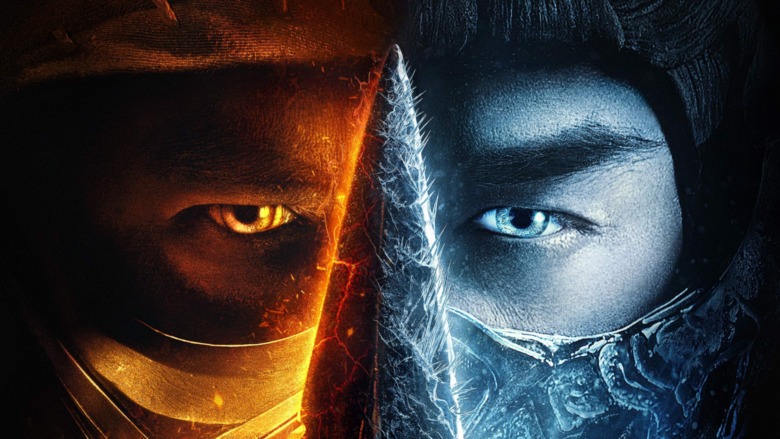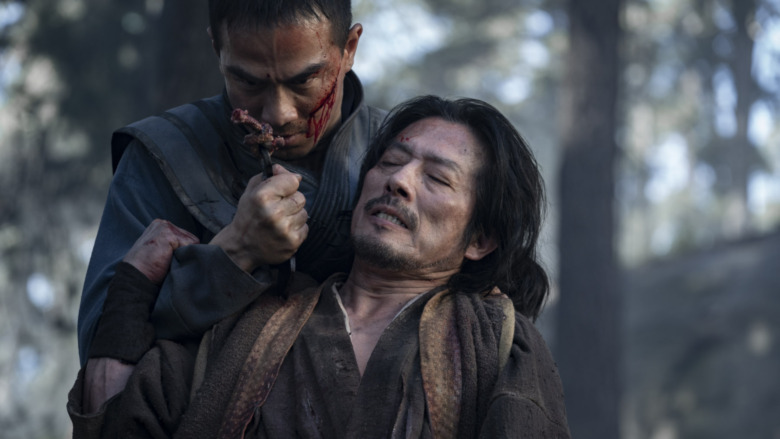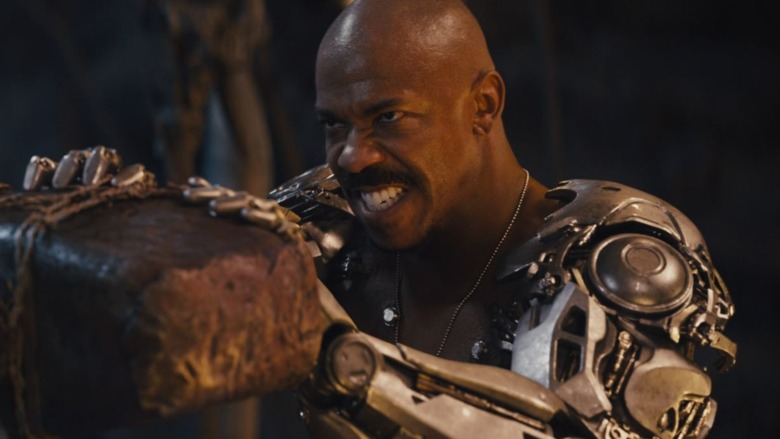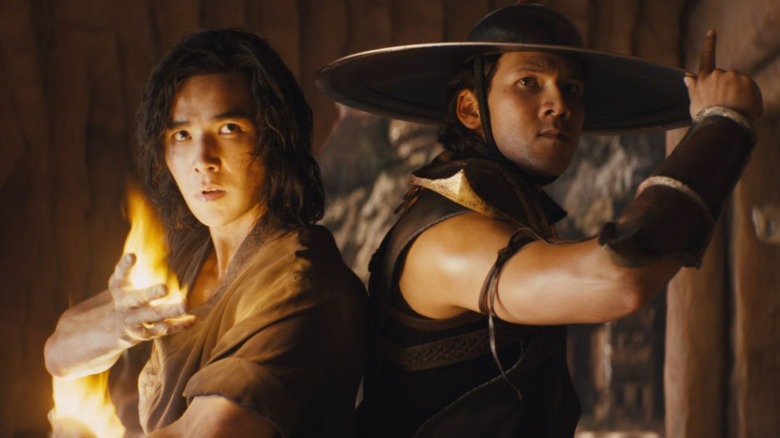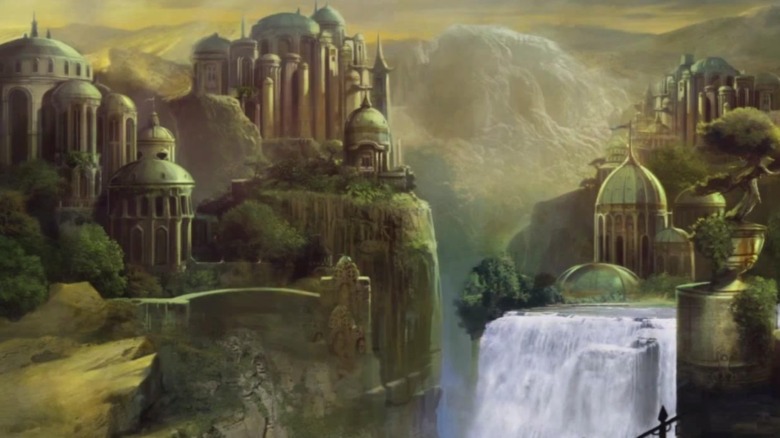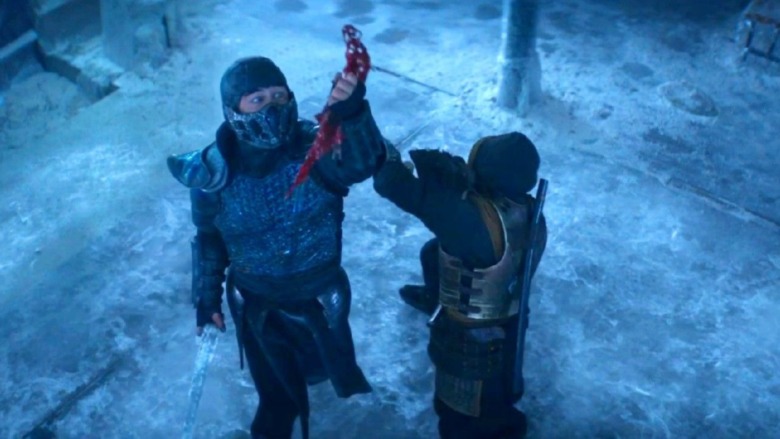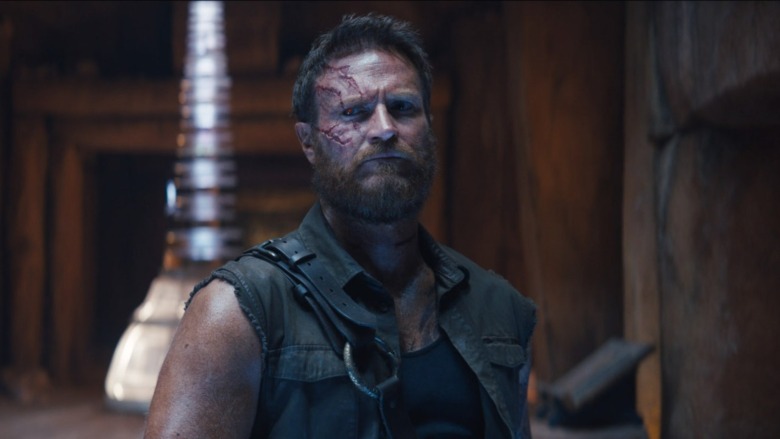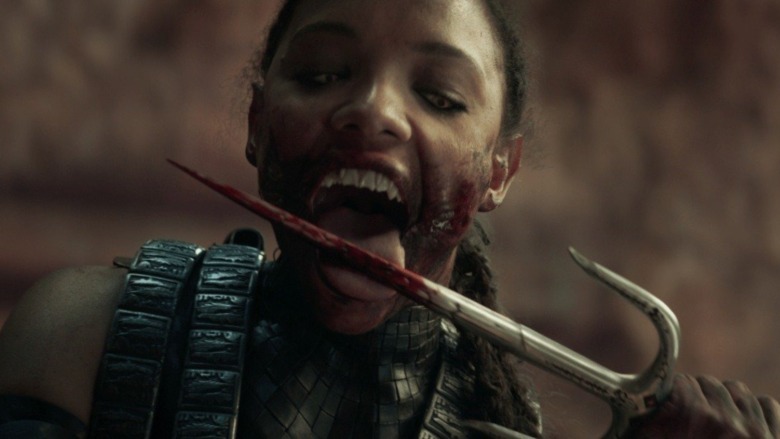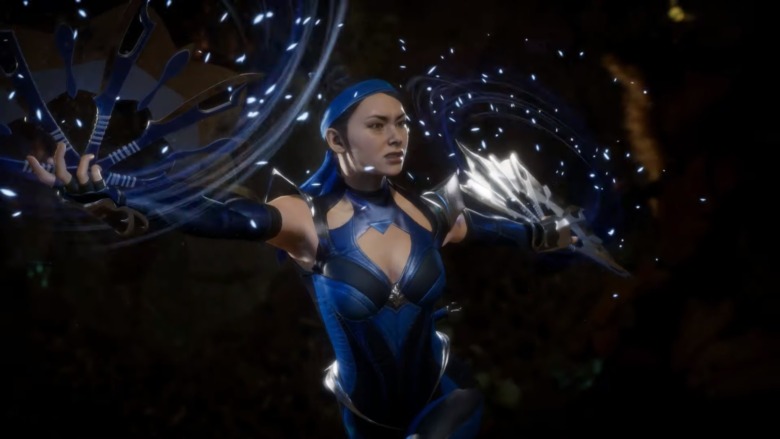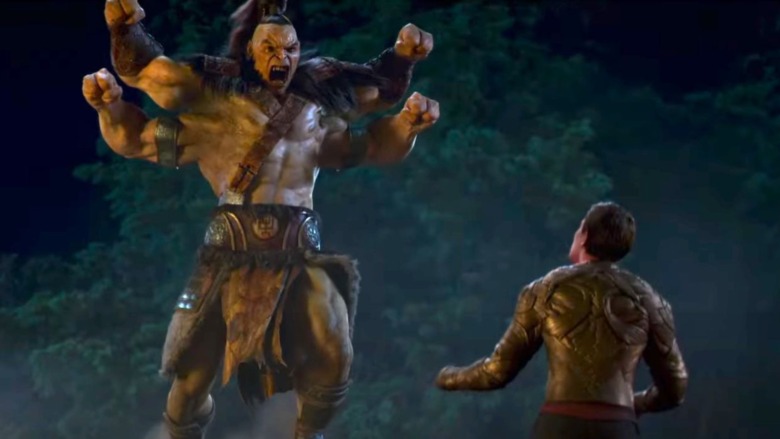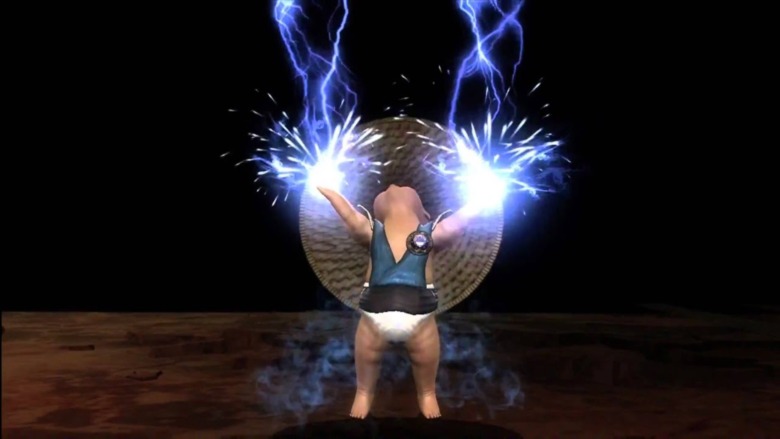Biggest Unanswered Questions In Mortal Kombat
It's been a while since we last saw a "Mortal Kombat" film adaptation on the big screen, and the new cinematic revival of the classic fighting game franchise definitely delivers pretty much everything a diehard fan could want. Iconic characters that look, sound, and act like their video game counterparts? It's got that. Brutal, fast-paced fight scenes? Yup, it has those, too. The games' most memorable catchphrases, gory finishers, and bucket after bucket of blood? Check, check, and check, friends.
If you're not familiar with the "Mortal Kombat" games, however, you may find yourself a little lost while watching the latest adaptation. Not because the movie's story is complicated, of course. If anything, it's actually a little too simple. As its title implies, "Mortal Kombat" focuses on the fighting, and while that's probably the right call, it leaves little room for much of anything else. Hoping for detailed explanations of some of the more obscure pieces of "Mortal Kombat" lore or a chance to slow down and catch up on why things are happening the way they are? Yeah, sorry. You're on your own.
As a result, some of the finer points of the story the 2021 "Mortal Kombat" movie is telling get lost in the shuffle, especially if you're not already familiar with its world. Here's a look at just a few of the questions we still had once the credits rolled (and if you haven't seen the movie yet, turn back now). Good luck finding answers, though. Unless you're willing to flip on a game console and dive into the "Mortal Kombat" game series, these will all most likely remain unanswered.
How did this whole thing start?
When it comes to setting things up and laying the groundwork for what's to follow, "Mortal Kombat" is nothing if not ruthlessly efficient. Two dimensions — Earthrealm, which is ours, and Outworld — are locked in a centuries-long battle for control. Occasionally, champions for both sides go head-to-head in a fighting tournament called Mortal Kombat. The first dimension to win Mortal Kombat ten times gets control of the other. As the movie opens, Outworld has nine victories to Earthrealm's zero, but there's an ancient prophecy that says a hero will emerge on Earthrealm, unite its heroes, and change the tide.
Okay, great. The structure of the movie is established, the stakes are set, and it's time to fight. If you're making a "Mortal Kombat" movie, that's really all you need. However, the world-building in "Mortal Kombat" falls apart as soon as you start to ask questions. Who set this whole thing up? Why did they decide that a fighting tournament was the best way to deal with inter-realm strife? How did ten become the magic number marking an all-encompassing victory? Where did the prophecy regarding Hanzo Hasashi's descendants come from, and why should we believe it?
"Mortal Kombat" alludes to some elder gods whose rules are "set in stone" — rules that both sides go on to break without suffering any consequences of note — but while that's an answer, it's not really an explanation. Maybe the inevitable "Mortal Kombat" sequel will dive a little deeper into these questions — or maybe not. As long as people are beating each other into bloody pulps, most of the audience probably won't care.
Who did Jax and Kano kill to get their marks?
According to "Mortal Kombat," there are two ways to get the mysterious dragon marks that designate you as a mortal kombatant and give you arcana-fueled superpowers: You can be born with one, or you can earn one by killing someone who's already marked. For example, as Hanzo Hasashi's direct descendent, Cole Young has had his mark his entire life. Sonya Blade, on the other hand, had to earn her mark the hard way. She wasn't marked until she killed Kano, although as we've seen, she was more than a match for the brash mercenary even without any special abilities.
As Sonya explains, Jax and Kano also got their marks through violence. Jax received his after tracking down a fugitive as part of his military duties, while Kano killed the target Jax and Sonya were tracking once they began investigating the marks. "Mortal Kombat" doesn't clue us in to who these two characters were, however. The closest that we get is a newspaper clipping that we can see on Sonya's wall as she tells Cole all about Jax's backstory: Scattered among the headlines, we see something about the mysterious death of a famous boxer.
However, there's no explicit link between the late athlete and Jax (in fact, its position on the board implies that it's more likely part of Cole's mysterious past), and there are no boxer-type characters in the extended "Mortal Kombat" canon. If these people had dragon marks, it stands to reason that they were probably pretty important. Unfortunately, their identities remain unknown.
What happened to Raiden's temple?
Look, Raiden has been at this whole Mortal Kombat thing for a long time. He pops up in the movie's prologue, rescuing Hanzo Hasashi's daughter in order to make sure the prophecy is upheld, and he's still fighting centuries later, when Shang Tsung decides he's going to preemptively take out all of Earthrealm's champions and win the latest Mortal Kombat tournament before it even begins.
By implication, his temple has been around for a while too, but it wasn't always so quiet. When Liu Kang welcomes Cole, Sonya, and Kano to the temple, he notes that it was once a place of worship. Presumably, Raiden once had many followers who flocked to the holy site. There's nothing to indicate what changed, though. These days, it's simply desolate and abandoned. No reason is given.
Raiden's temple also introduces a few other mysteries: mainly, how did Kano know where it is? Sonya seems to think the temple is very well hidden, but Kano implies that people can't stop talking about it. Either Sonya and Jax are terrible investigators, or Kano really knows more than he's letting on.
How many realms are there, and what are they called?
"Mortal Kombat" is lousy with alternate dimensions, but the movie only introduces us to two of them. There's Earthrealm, where most of the action takes place. There's Outworld, where Shang Tsung lives, and which threatens to take over Earth for good. Finally, there's Netherrealm, which is basically Hell (and which shares a name with the development studio that's been making Mortal Kombat games for the past decade or so).
But there are others, too, which the movie doesn't have time to explore. The video games, on the other hand, have fleshed out the franchise's multiverse to an absurd degree. In addition to the three realms already mentioned, the games have also introduced players to Edenia, a fairy tale-like fantasy world, Orderrealm, where law reigns supreme, the anything-goes Chaosrealm, and Heaven, which is pretty much exactly what it sounds like.
It's never made clear whether or not the new movie universe follows the same cosmology, although hints may be lurking in some of the film's better hidden Easter eggs. Honestly, we wouldn't be surprised to see Edenia make an appearance in a sequel — at least one fan-favorite character makes the realm her home — but for now, the slate is still wide open.
What is the Lin Kuei, the Shirai Ryu, and the Shokan?
The "Mortal Kombat" games have dense lore, and the movie does a pretty good job of bringing it all to life on the screen. Bi-Han, better known as Sub Zero, mentions the Lin Kuei a few times. Scorpion fights for the Shirai Ryu. Goro, Shang Tsung's four-armed minion, is hailed as the prince of the Shokan. "Mortal Kombat" doesn't have time to explain what all of these words mean, though. If you're a fan of the games, you probably cheered. If you went into the movie blind, you're probably very confused.
We still don't know if these words mean the same thing in the movies, but the games can give us a few clues. Traditionally, the Lin Kuei and the Shirai Ryu are competing groups of martial artists. The Lin Kuei, of which Sub-Zero is the most famous but far from the only member, hail from China. At some point, a Japanese-born ninja broke off from the group and founded the Shirai Ryu, leading to a long rivalry. The Shokan, meanwhile, are a race of half-dragon, half-human warriors who value strength over all else. Even the king and queen's children must fight among themselves in order to determine the Shokan's one true heir.
"Mortal Kombat" is filled with stuff like that, so if you want an explanation for terms like Bo' Rai Chai or references to the Wu Shi Academy, you'll need to look to the games. They'll help you find the answers on your own.
What went down between Kano and Kabal?
Wisecracking merc Kano and armor-clad warrior Kabal have a history. According to Kabal, Kano is the reason why he's hidden under a hulking metal suit. Want to know more? Too bad. "Mortal Kombat" establishes that the two characters have a fractious relationship, but the specifics remain a mystery.
Clearly, Kano and Kabal's falling out has something to do with the Black Dragon, which seems to be both a title and the name of an organization. Once again, this is an area where the games can help us out. In the "Mortal Kombat" games, the Black Dragon is a criminal cabal made up of mercenaries. Kano is its leader, Kabal was one of its members, and Jax was the Special Forces operative tasked with bringing the whole thing down (in the games, Jax is responsible for Kano's facial scars, not Reptile).
The movie seems like it's switched things up a little. It sure doesn't sound like Kano's in charge of the Black Dragon — or, really, much of anything — and we don't know why he and Kabal fought, what happened to the Black Dragon, or what specifically Kabal offered him to switch sides. This is something that could get more attention in a later "Mortal Kombat" movie, but given the way that both characters ended up — i.e. dead — we're not going to hold out any hope.
Are all of these characters really dead?
"Mortal Kombat" manages to squeeze every character from the first game (with one big exception, who's clearly being saved for the next installment) and most of those from the second into the movie, in addition to a bunch of characters from later entries in the series. It also manages to kill a bunch of them off. Kano, Reptile, Goro, Mileena, Kung Lao, and Sub-Zero all die in brutal, bloody fashion before the end credits roll, making their appearance in any sequels pretty unlikely.
Or is it? These are some of the most iconic characters in the entire franchise, and it's hard to imagine a "Mortal Kombat" movie without them. Sub-Zero will be easy to replace without deviating too far from established canon — in the games, the Sub-Zero mantle is taken up by Bi-Han's younger brother, Kuai Liang — but the movie introduces a loophole for everyone else, too. After all, Hanzo Hasashi dies in the pre-credit sequence, only to return at the film's climax stronger than ever. Who's to say the rest of the kombatants can't do the same?
Where is Kitana?
The writers behind "Mortal Kombat" deserve lots of credit for pulling some pretty deep cuts from the franchise's expansive roster, but those surprises come at a cost. Sure, it's fun to see relatively obscure characters like Nitara and Reiko get a spotlight, but we never would've expected them to make their big-screen debut before the likes of characters like Jade, or Kenshi, or Smoke, or Shao Kahn.
That goes double for Kitana, given her close ties to Mileena, who features prominently in "Mortal Kombat" as Shang Tsung's second-best warrior, following Sub-Zero. In the games, Mileena and Kitana are twins, at least when they're wearing their masks — they're basically the female equivalents of Scorpion and Sub-Zero. For most of her life, Kitana worked as an Outworld assassin, and believed that she and Mileena were sisters. Only later did she discover the reality of the situation: In truth, Kitana is the princess of Edenia, and Mileena isn't a relative but her evil clone.
In fairness, that's a lot of extra story for a movie that's already packed with characters, but given Mileena's fate in "Mortal Kombat," it's a shame that Kitana didn't get a chance to share the screen with her "sister" at least once. Given Kitana's popularity and links to the rest of the "Mortal Kombat" cast — she's also been a love interest for Liu Kang — her omission is mildly baffling.
Wait, is the tournament still happening?
So, here's the thing about "Mortal Kombat": It might've ended before we actually got to see, well, Mortal Kombat. As the movie reveals, Mortal Kombat is the name of the tournament that pits Earthrealm's fighters against Outworld's. Shang Tsung's evil scheme is to hunt down and take out Earthrealm's forces before the tournament begins, leaving his side with a victory by default.
Ultimately, Cole Young rallies the good guys and decides to fight Tsung's warriors on his own terms, but other than a throwaway line about bringing the tournament to them, there's no indication that Mortal Kombat has actually started. In fact, the movie implies the opposite. When Young and the rest first arrive at Raiden's temple, Liu Kang hints that the tournament is about a month away,but it sure doesn't seem like anyone spends more than a few days training.
However, when the movie ends, it's played like Earthrealm has won. That means one of a few things have happened. One, maybe the movie's sense of time is just skewed, and the one-on-one battles that make up the film's climax comprise the actual tournament (this seems unlikely since, strictly speaking, that's not really how tournaments work). Two, with Outworld's forces decimated, the tournament has been postponed or canceled. Three, the tournament is still going to happen at the designated date, and we just haven't gotten there yet. That last option seems absurd, but it also explains why Young wants to get to Hollywood to recruit Johnny Cage as quickly as possible. So... maybe?
Where are the Babalities?
Fatalities aren't just a "Mortal Kombat" staple. They actually made history. The gruesome finishing moves were so controversial that the video game industry created the Entertainment Software Rating Board, the organization that slaps movie-like content ratings on games, in an effort to curtail public outrage.
Midway, developer of "Mortal Kombat," didn't respond by cutting down on fatalities, though. Instead, it stuffed later "Mortal Kombat" titles full of other finishing moves, some of which poked fun at the scandal that led to the ESRB. After executing an Animality, a player's character transforms into a beast, then proceeds to maul their opponent. A Friendship is like an anti-Fatality that ends a match with a harmless gesture, like blowing bubbles or giving an opponent a birthday cake. Quitalities are reserved for players who disconnect during online matches, while Hari-Kiris let defeated players off themselves before their opponents get the chance.
The most memorable, though, are Babilities, which turn rival fighters into infants. Sadly, while "Mortal Kombat" is full of classic fatalities — remember when Kano rips out Reptile's heart? Yeah, you've seen that before — the movie is entirely Babality free. Oh well. Maybe next time.
